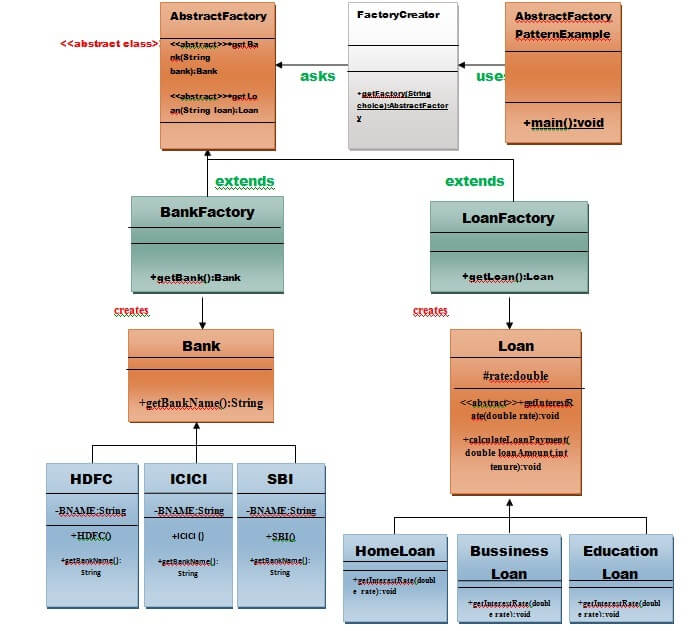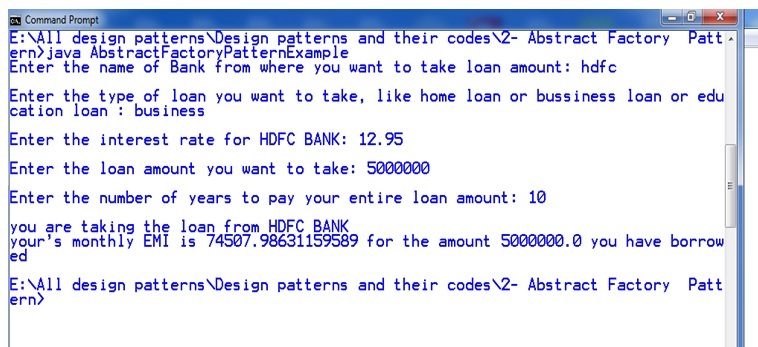Abstract Factory Pattern表示仅定义一个接口或抽象类来创建相关(或依赖)对象的族, 但不指定其具体子类, 这意味着Abstract Factory让一个类返回类的工厂。因此, 这就是“抽象工厂模式”比“工厂模式”高一级的原因。
抽象工厂模式也称为Kit。
抽象工厂模式的优势
- 抽象工厂模式将客户代码与具体的(实现)类隔离。
- 它简化了对象族的交换。
- 它促进对象之间的一致性。
抽象工厂模式的用法
- 系统何时需要独立于其对象的创建, 组成和表示方式。
- 当相关对象系列必须一起使用时, 则需要强制执行此约束。
- 当你想要提供一个不显示实现而仅显示接口的对象库时。
- 当系统需要配置多个对象系列之一时。
用于抽象工厂模式的UML
- 我们将创建一个Bank接口和一个Loan抽象类及其子类。
- 然后, 我们将创建AbstractFactory类作为下一步。
- 然后, 我们将创建具体的类BankFactory和LoanFactory来扩展AbstractFactory类
- 之后, AbstractFactoryPatternExample类使用FactoryCreator来获取AbstractFactory类的对象。
- 请仔细查看下图:

抽象工厂模式示例
在这里, 我们正在计算HDFC, ICICI, SBI等不同银行的贷款偿还额。
步骤1:建立银行介面
import java.io.*;
interface Bank{
String getBankName();
}步骤2:创建实现Bank接口的具体类。
class HDFC implements Bank{
private final String BNAME;
public HDFC(){
BNAME="HDFC BANK";
}
public String getBankName() {
return BNAME;
}
}class ICICI implements Bank{
private final String BNAME;
ICICI(){
BNAME="ICICI BANK";
}
public String getBankName() {
return BNAME;
}
}class SBI implements Bank{
private final String BNAME;
public SBI(){
BNAME="SBI BANK";
}
public String getBankName(){
return BNAME;
}
}步骤3:创建Loan抽象类。
abstract class Loan{
protected double rate;
abstract void getInterestRate(double rate);
public void calculateLoanPayment(double loanamount, int years)
{
/*
to calculate the monthly loan payment i.e. EMI
rate=annual interest rate/12*100;
n=number of monthly installments;
1year=12 months.
so, n=years*12;
*/
double EMI;
int n;
n=years*12;
rate=rate/1200;
EMI=((rate*Math.pow((1+rate), n))/((Math.pow((1+rate), n))-1))*loanamount;
System.out.println("your monthly EMI is "+ EMI +" for the amount"+loanamount+" you have borrowed");
}
}// end of the Loan abstract class.步骤4:创建扩展Loan抽象类的具体类。
class HomeLoan extends Loan{
public void getInterestRate(double r){
rate=r;
}
}//End of the HomeLoan class.class BussinessLoan extends Loan{
public void getInterestRate(double r){
rate=r;
}
}//End of the BusssinessLoan class.class EducationLoan extends Loan{
public void getInterestRate(double r){
rate=r;
}
}//End of the EducationLoan class.第5步:创建一个抽象类(即AbstractFactory)来获取Bank和Loan Objects的工厂。
abstract class AbstractFactory{
public abstract Bank getBank(String bank);
public abstract Loan getLoan(String loan);
}步骤6:创建继承AbstractFactory类的工厂类, 以基于给定的信息生成具体类的对象。
class BankFactory extends AbstractFactory{
public Bank getBank(String bank){
if(bank == null){
return null;
}
if(bank.equalsIgnoreCase("HDFC")){
return new HDFC();
} else if(bank.equalsIgnoreCase("ICICI")){
return new ICICI();
} else if(bank.equalsIgnoreCase("SBI")){
return new SBI();
}
return null;
}
public Loan getLoan(String loan) {
return null;
}
}//End of the BankFactory class.class LoanFactory extends AbstractFactory{
public Bank getBank(String bank){
return null;
}
public Loan getLoan(String loan){
if(loan == null){
return null;
}
if(loan.equalsIgnoreCase("Home")){
return new HomeLoan();
} else if(loan.equalsIgnoreCase("Business")){
return new BussinessLoan();
} else if(loan.equalsIgnoreCase("Education")){
return new EducationLoan();
}
return null;
}
}步骤7:创建FactoryCreator类, 以通过传递诸如银行或贷款之类的信息来获取工厂。
class FactoryCreator {
public static AbstractFactory getFactory(String choice){
if(choice.equalsIgnoreCase("Bank")){
return new BankFactory();
} else if(choice.equalsIgnoreCase("Loan")){
return new LoanFactory();
}
return null;
}
}//End of the FactoryCreator.步骤8:使用FactoryCreator来获取AbstractFactory, 以便通过传递诸如类型之类的信息来获得具体类的工厂。
import java.io.*;
class AbstractFactoryPatternExample {
public static void main(String args[])throws IOException {
BufferedReader br=new BufferedReader(new InputStreamReader(System.in));
System.out.print("Enter the name of Bank from where you want to take loan amount: ");
String bankName=br.readLine();
System.out.print("\n");
System.out.print("Enter the type of loan e.g. home loan or business loan or education loan : ");
String loanName=br.readLine();
AbstractFactory bankFactory = FactoryCreator.getFactory("Bank");
Bank b=bankFactory.getBank(bankName);
System.out.print("\n");
System.out.print("Enter the interest rate for "+b.getBankName()+ ": ");
double rate=Double.parseDouble(br.readLine());
System.out.print("\n");
System.out.print("Enter the loan amount you want to take: ");
double loanAmount=Double.parseDouble(br.readLine());
System.out.print("\n");
System.out.print("Enter the number of years to pay your entire loan amount: ");
int years=Integer.parseInt(br.readLine());
System.out.print("\n");
System.out.println("you are taking the loan from "+ b.getBankName());
AbstractFactory loanFactory = FactoryCreator.getFactory("Loan");
Loan l=loanFactory.getLoan(loanName);
l.getInterestRate(rate);
l.calculateLoanPayment(loanAmount, years);
}
}//End of the AbstractFactoryPatternExample输出量

 srcmini
srcmini
评论前必须登录!
注册